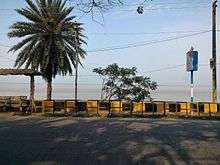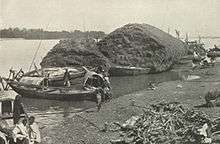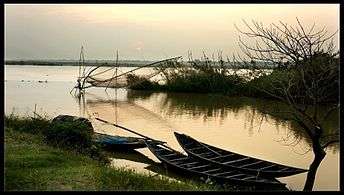Hooghly River



The Hooghly River (Bengali: হুগলী নদী) (Hugli; Anglicized alternatively spelled Hoogli or Hugli) or the Bhāgirathi-Hooghly, called 'Ganga' traditionally, is an approximately 260-kilometre-long (160 mi) distributary of the Ganga river in West Bengal, India.[1] It splits from the Ganges as a canal in Murshidabad District at the Farakka Barrage. The town of Hugli-Chinsura, formerly Hooghly, is located on the river, in the Hooghly (district).[2] The origins of the Hooghly name are uncertain, whether the city or the river was named first.
Course
The Farakka Barrage is a dam that diverts water from the Ganges into a canal near the town of Tildanga in Murshidabad district. This supplies the Hooghly with adequate water even in the dry season. It parallels the Ganges, past Dhulian, until just above Jahangirpur where the canal ends and the river takes its own course. Just south of Jahangirpur it leaves the Ganges area and flows south past Jiaganj Azimganj, Murshidabad, and Baharampur. South of Baharampur and north of Palashi it used to form the border between Bardhaman District and Nadia District, but while the border has remained the same the river is now often east or west of its former bed. The river then flows south past Katwa, Navadwip and Kalna. At Kalna it originally formed the border between Nadia District and Hooghly District, and then further south between Hooghly District and North 24 Parganas District. It flows past Halisahar, Chinsurah, Serampore, and Kamarhati. Then just before entering the twin cities of Kolkata (Calcutta) and Howrah, it turns to the southwest. At Nurpur it enters an old channel of the Ganges and turns south to empty into the Bay of Bengal through the estuary of about 20 mi (32 km) wide.[3]
Two of its primary tributaries are Damodar and Rupnarayan.
Tidal bore
The tide runs rapidly on the Hooghly, and produces a remarkable example of the fluvial phenomenon known as a "tidal bore." This consists of the head-wave of the advancing tide, hemmed in where the estuary narrows suddenly into the river, and often exceeds 7 ft (2.1 m) in height. It is felt as high up as Kolkata, and frequently destroys small boats. The difference from the lowest point of low-water in the dry season to the highest point of high-water in the rains is reported to be 20 ft 10 in (6.35 m). The greatest mean rise of tide, about 16 ft (4.9 m), takes place in March, April or May - with a declining range during the rainy season to a mean of 10 ft (3.0 m), and a minimum during freshets of 3 ft 6 in (1.07 m).
History

In its upper reaches the river is generally known as the Bhāgirathi, until it reaches Hooghly. The word Bhāgirathi literally means "caused by Bhagiratha", a mythical Sagar Dynasty prince who was instrumental in bringing the river Ganges from the heavens on to the earth, in order to release his 60,000 grand-uncles from a curse of the saint Kapila.
In 1974, the Farakka Barrage began diverting water into the Hooghly during the dry season so as to reduce the silting difficulties at Kolkata's port.
Like the rest of the Ganges, the Bhāgirathi-Hooghly is considered sacred to Hindus, and its water is considered holy.
Economics
_by_Piyal_Kundu.jpg)
The Bhāgirathi-Hooghly river system is an essential lifeline for the people of West Bengal. It was through this river that the East India company sailed into Bengal and established their trade settlement, Calcutta, the capital of British India. People from other countries such as the French, Dutch, Portuguese, etc. all had their trade settlements by the banks of this river.
The river provides a perennial supply of water to the plain of West Bengal for irrigation and human & industry consumption. The river is navigable and a major transport system in the region with a large traffic flow. For a long time, the Calcutta Port was the biggest port of India. Although in the past its significance had gone down, recently it has reached the 3rd position in the list of Indian Ports. The modern container port of Haldia, on the intersection of lower Hooghly and Haldi River, now carries much of the region's maritime trade. One new port will be built in the deep sea to reduce the load on Calcutta port.
Despite being polluted, the fish from the river are important to the local economy.
The Hooghly river valley was the most important industrial area of the state of Bengal. Due to declining jute industry, the prime industry of this region, but it is still one of the biggest industrial areas of India. It has number of small cities which forms the Greater Kolkata agglomeration, the second biggest Indian city and former capital.
Several bridges run over the Hooghly at Kolkata – Howrah Bridge, Vidyasagar Setu, Vivekananda Setu, Nivedita Setu (second Vivekananda Bridge), Jubilee Bridge (chinsurah) and Iswar Gupta Setu.
In September 2015, the Government of West Bengal announced that renovation of the Hooghly riverfront in Kolkata will be completed with the help of World Bank funding under the National Ganga River Basin Project Scheme.[4]
Gallery
 Boats and men on the banks of the Hooghly river, 1915.
Boats and men on the banks of the Hooghly river, 1915.- The Floatel in Kolkata located on the river itself.
 The Prinsep Ghat which is located on the bank of the Hooghly River
The Prinsep Ghat which is located on the bank of the Hooghly River Boats on the river at Shimurali, Nadia district
Boats on the river at Shimurali, Nadia district- The river behind Hazarduari Palace in Murshidabad district
- The city of Kolkata lies along the banks of the Hooghly.
- Boat view from bank of Hoogly river Kolkata
In literature
Rudyard Kipling wrote an article, On the Banks of the Hugli[5] (1888), and a short story set on the Hooghli, An Unqualified Pilot[6] (1895).
See also
References
- ↑ "Hugli River - river, India".
- ↑ "District". Voiceofbengal.com.
- ↑ "Hugli River". Encyclopedia Britannica. Retrieved 8 July 2016.
- ↑ "World Bank to fund Hooghly riverfront revamp - Times of India".
- ↑ "Chapter IV - City of Dreadful Night - From Sea to Sea - Rudyard Kipling, Book, etext". Telelib.com. 1 February 2003. Retrieved 25 August 2013.
- ↑ "An Unqualified Pilot - Land & Sea Tales - For Scouts and Guides - Rudyard Kipling, Book, etext". Telelib.com. 1 March 2003. Retrieved 25 August 2013.
 This article incorporates text from a publication now in the public domain: Chisholm, Hugh, ed. (1911). "Hugli (river)". Encyclopædia Britannica (11th ed.). Cambridge University Press.
This article incorporates text from a publication now in the public domain: Chisholm, Hugh, ed. (1911). "Hugli (river)". Encyclopædia Britannica (11th ed.). Cambridge University Press.
External links
| Wikimedia Commons has media related to Hooghly River. |
Coordinates: 21°55′N 88°05′E / 21.917°N 88.083°E